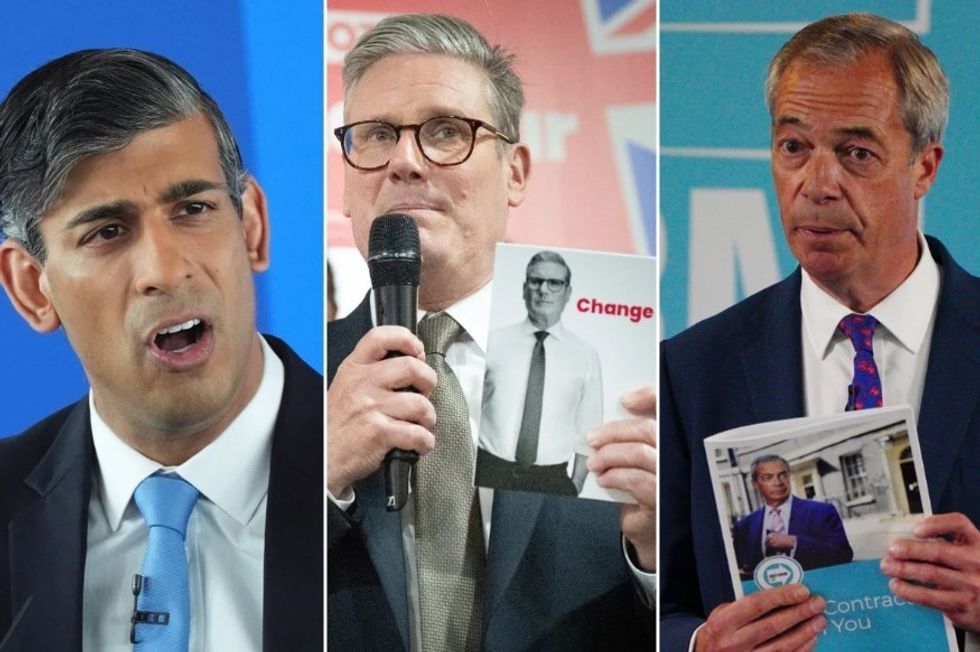Political parties have unveiled their manifestos over the past week
PA
'Despite what cynics might say, manifestos are taken seriously by the politicians who write them'
Don't Miss
Most Read
Trending on GB News
We now have all the manifestos of the political parties standing in this General Election. In Nigel Farage’s Reform UK case we have a contract. But then Reform is more a company than a political party and companies have contracts rather than manifestos.
The diligent undecided voter should read them. Manifestos will tell you which party is most likely to serve your interests in government, and whether they share your values.
Despite what cynics might say, they are taken seriously by the politicians who write them, not least because the House of Lords cannot vote down a manifesto commitment.
But bear in mind unpredicted events can knock any administration off course as the financial crash in 2008 did, and more recently Covid and the war in Ukraine.

We now have all the manifestos of the political parties standing in this General Election
PA
Which means manifestos cannot be taken as an absolute guarantee of what to expect, just what a future government intends to deliver given a fair wind and five years of stability.
With only a couple of weeks till the polls open, there’s not a lot of time to wade through these weighty documents. Except perhaps for the mini-sized Climate Party who issued a mini-manifesto of just 272 words with an ambitious proposal for net zero 20 years before anyone else.
But there is a shortcut. Go to the couple of pages at the end where spending plans are costed and decide for yourself whether they sound realistic. This is where the bodies are buried.
You won’t need a degree in mathematics as the figures are laid out fairly simply, but it’s worth keeping a calculator to hand. And you still will be left scratching your head.
Take the Labour and Tory costings. Labour is relying on a crackdown on tax avoidance and closing non-dom tax loopholes to raise £5.2billion. And another £1.5billion from charging VAT on private school fees.
Raking this money in will rely on non-doms not packing up and leaving the country. A study by the London School of Economics and Warwick University reckons only 100 of 26,000 will. And the Institute for Fiscal Studies says most parents are likely to cough up the extra 20 per cent for school fees.
This prediction is based on fees for private schools going up 55 per cent in real terms over the last 20 years while the proportion of mums and dads who send their kids to one has remained stable at around seven per cent.
It is for you to decide whether the pointy-heads have got all this right.
The Tories says they will raise £12billion from a clampdown on welfare payments and £6billion from catching tax dodgers. When George Osborne was Chancellor he also thought he could save £12billion from benefits - and when it came to it fell £4billion short.
But it’s the tax avoidance figures which gave my scalp an itch. Of Labour's £5.2billion more than £1billion comes from the non-doms which leaves around £4billion from milking tax cheats.
Even a math dunce like me can subtract 4 from 6 and see there is a £2billion discrepancy in these estimates between Labour and Conservatives. If the two main parties are both snuffling around the same pot they can’t both be right.
The Tories seem to be basing their figure on an interview the head of the National Audit Office gave to the Financial Times in January when he said there was £6billion of uncollected tax sloshing around out there.
For the Treasury to get their hands on it, though, it has to be collected. And both parties are a little vague how that might be done. The choice, then, is between Labour’s more cautious number or the optimistic Tory one.
Or they could both be wrong and the dodgers will continue successfully playing dodgems with HMRC.
Now let’s turn to Reform, whose figures look like they have been drawn up on the back of one of Nigel’s fag packets. Take a look and decide whether a £20,000 tax free personal allowance - welcome though it would be - is really feasible in the current economic climate. Or about as likely as Count Binface’s plan to cap the price of croissants at £1.10.
Have a gander at one of Reform’s health promises and the laudable aim of giving patients a voucher to see a private GP if they cannot get an appointment with an NHS one within three days.
Uh-huh. How would that work then? Family doctors deal with 358 million appointments a year. But there are only 3,000 private GPs. Given the work overload Reform would create for them, private GPs would need to see a GP, too.
If you are an enthusiast for a particular political party you will have already decided which is the best option. If not, you will be left with opting for the least worst.







